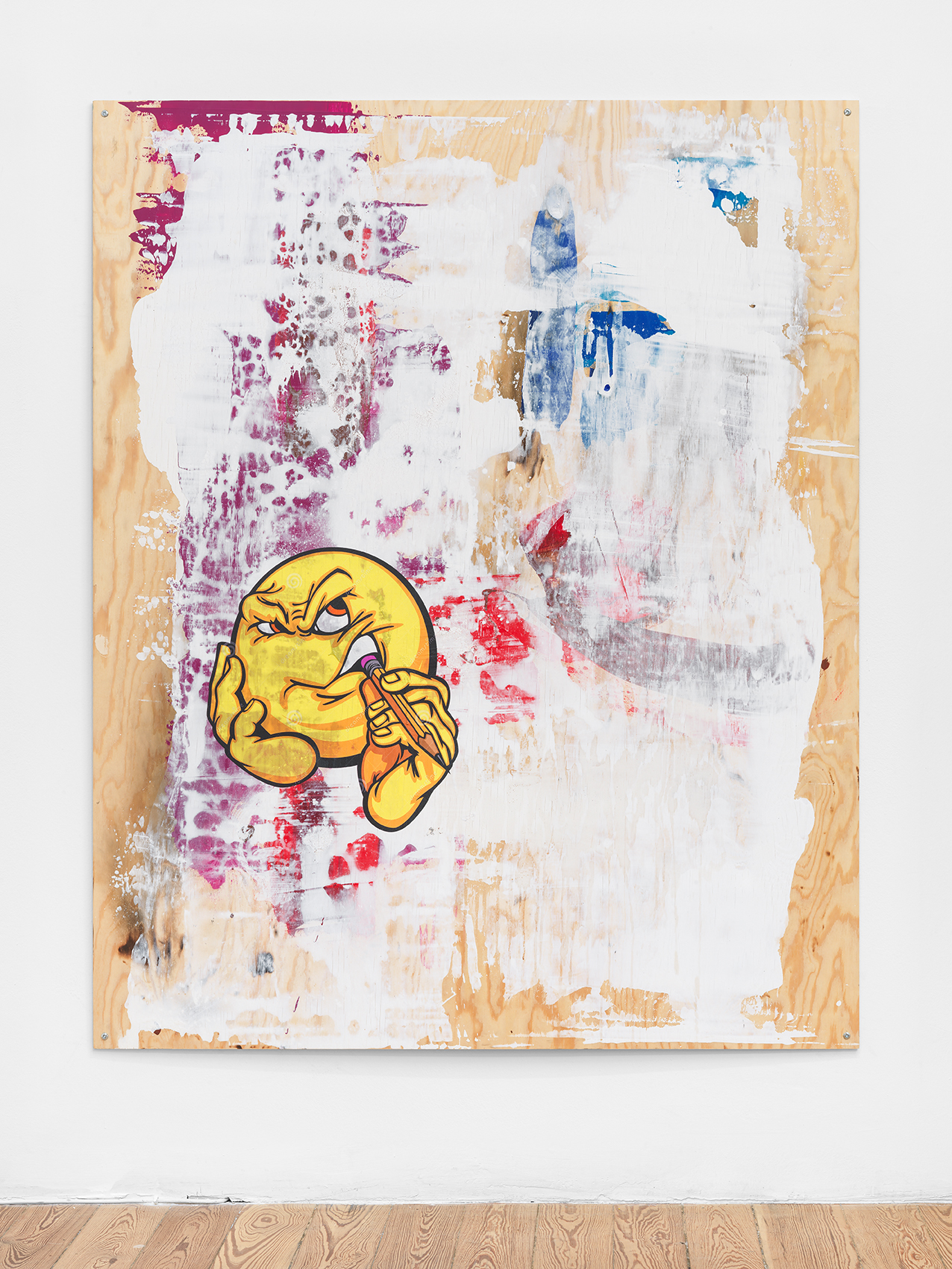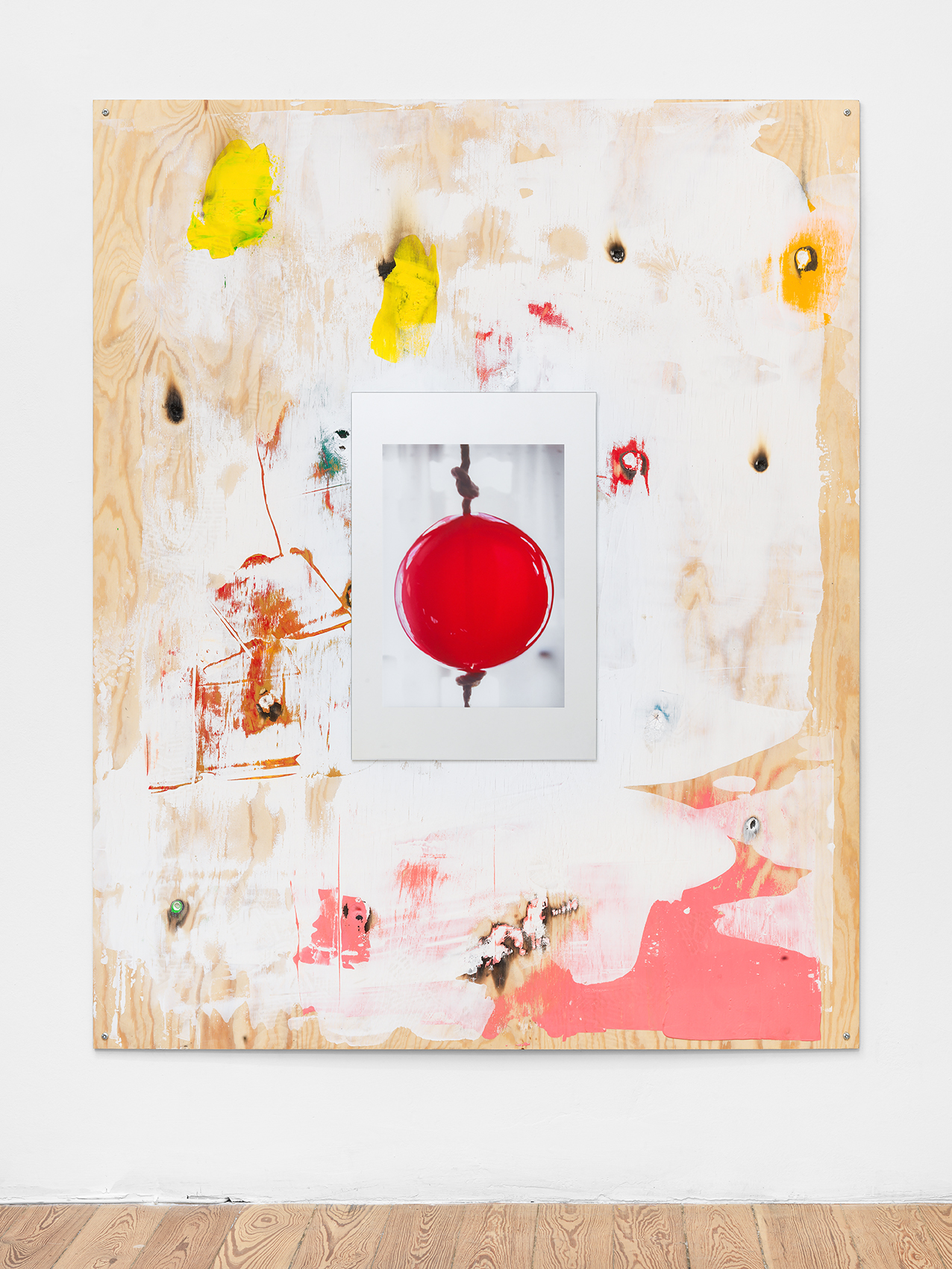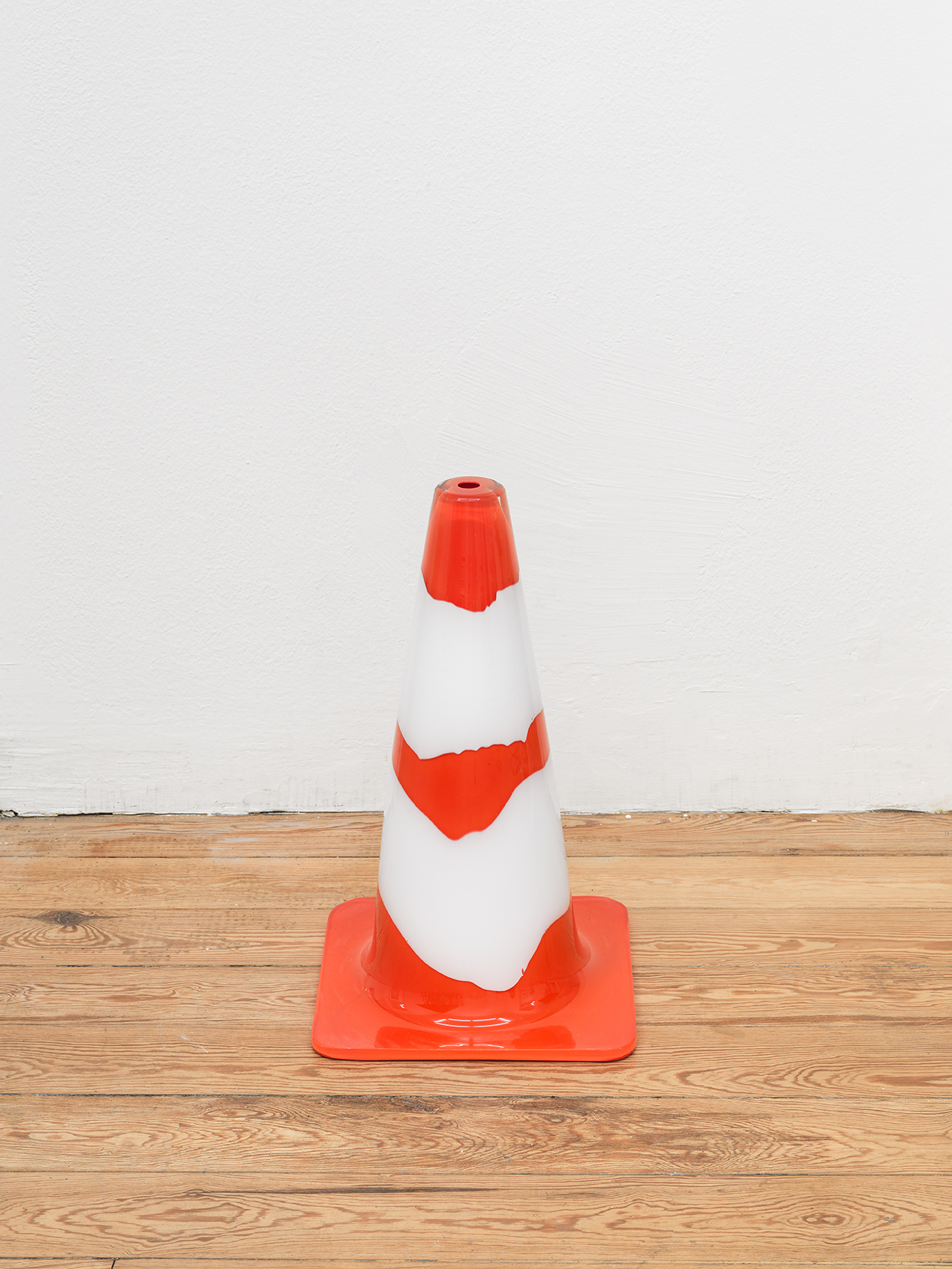Kaspar Müller
Maintenance
December 21, 2017 - January 27, 2018
Kaspar Müller, Maintenance, 2017, installation view, Galleria Federico Vavassori, Milan
Kaspar Müller, Maintenance, 2017, installation view, Galleria Federico Vavassori, Milan
Kaspar Müller, Maintenance, 2017, installation view, Galleria Federico Vavassori, Milan
Kaspar Müller
Untitled, 2017
Wooden board,acrylics, inkjet print
155 x 125 cm
Kaspar Müller
Untitled, 2017
Wooden board, print on glass mirror, acrylics
155 x 125 cm
Kaspar Müller
Untitled, 2017
Wooden board, print on glass mirror, acrylics
155 x 125 cm (detail)
Kaspar Müller, Maintenance, 2017, installation view, Galleria Federico Vavassori, Milan
Kaspar Müller, Maintenance, 2017, installation view, Galleria Federico Vavassori, Milan
Kaspar Müller, Maintenance, 2017, installation view, Galleria Federico Vavassori, Milan
Kaspar Müller, Maintenance, 2017, installation view, Galleria Federico Vavassori, Milan
Kaspar Müller
Untitled, 2017
Glass cone
51 x 30 x 30 cm
Kaspar Müller, Maintenance, 2017, installation view, Galleria Federico Vavassori, Milan
Kaspar Müller, Maintenance, 2017, installation view, Galleria Federico Vavassori, Milan
Kaspar Müller
Untitled, 2017
Wooden board, acrylicas, glitter, push pins, print
155 x 125 cm
Kaspar Müller, Maintenance, 2017, installation view, Galleria Federico Vavassori, Milan
Kaspar Müller, Maintenance, 2017, installation view, Galleria Federico Vavassori, Milan
Kaspar Müller
Untitled, 2017
Wooden board with trestles, acrylics, various material
105 x 152 x 125 cm (detail)
Kaspar Müller, Maintenance, 2017, installation view, Galleria Federico Vavassori, Milan (detail)
Kaspar Müller, Maintenance, 2017, installation view, Galleria Federico Vavassori, Milan (detail)
Kaspar Müller
Untitled, 2017
Print on glass mirror
60 x 40 cm
Kaspar Müller, Maintenance, 2017, installation view, Galleria Federico Vavassori, Milan
Kaspar Müller
Untitled, 2017
Chair, acrylics, gouache
77 x 37 x 37 cm
Kaspar Müller, Maintenance, 2017, installation view, Galleria Federico Vavassori, Milan
Kaspar Müller, Maintenance, 2017, installation view, Galleria Federico Vavassori, Milan
Kaspar Müller
Untitled, 2017
Storage shelf, cds dvds
180 x 91,5 x 42 cm
Kaspar Müller, Maintenance, 2017, installation view, Galleria Federico Vavassori, Milan
Kaspar Müller
Untitled, 2017
Print on glass mirror
60 x 40 cm
Kaspar Müller, Maintenance, 2017, installation view, Galleria Federico Vavassori, Milan
Kaspar Müller, Maintenance, 2017, installation view, Galleria Federico Vavassori, Milan
Kaspar Müller
Untitled, 2017
Print on glass mirror
60 x 40 cm
Kaspar Müller, Maintenance, 2017, installation view, Galleria Federico Vavassori, Milan
- 2025
-
2024
-
Giangiacomo Rossetti
Squeeze
November 29, 2024 - January 10, 2025 -
Ganz kleine
November 6 - November 22, 2024 -
Kaspar Müller
when we turn, we reappear
September 18 - October 18, 2024 -
Gianni Piacentino
June 25 - July 25, 2024 -
Vincent Murnaghan
Tuscan Landscape Painting
May 22 - June 18, 2024 -
claude rutault
March 12 - April 26, 2024
-
-
2023
-
The 3-second rule of thumb
Curated by Kaspar Müller
December 15, 2023 - February 2, 2024 -
Daniele Milvio
Le Faremo Sapere.
September 21 - October 27, 2023 -
Charlemagne Palestine, C'ERAA UNAAA VOLTAAA CHARLEWORLDDD
June 6 - July 7, 2023 -
Bill Hayden
café Uranus
May 4 - 31, 2023 -
Gianni Piacentino
March 22 - April 23, 2023
-
Emil Michael Klein
January 17 - February 17, 2023
-
-
2022
-
Osama Al Rayyan
knights
November 9 - December 16, 2022 -
Rochelle Goldberg
Ghost Centrale
September 16 - October 21, 2022 -
Beatrice Marchi
Who crushed the Evil Turtle?
June 8 - July 29, 2022 -
Kaspar Müller
Maintenance 2
March 30 - May 13, 2022 -
6 Bagatelles
Osama Al Rayyan
Beatrice Marchi
Daniel Murnaghan
Matthew Pang
Giangiacomo Rossetti
Cinzia RuggeriFebruary 15 - March 18, 2022
-
- 2021
-
2020
-
PaJaMa (Paul Cadmus, Jared French, Margaret Hoening French)
September 25 - November 15, 2020
-
Jared Madere
In the back of the restaurant I made him kiss the ring: Haunted House in the Key of New Years
Paths to G-ddess~ Tiny Dick Timmy Ricochet~ Live from the Geomancer’s Clit Ring
You say one thing and everyone acts like you don’t mean the opposite of it at the same time tooFebruary 13 - March 27, 2020
-
-
2019
-
Renata Boero
Tempo e Tempi
November 15, 2019 - January 10, 2020 -
Doriana Chiarini
IN GRANDE! Scultura a dismisura
Curated by Mariuccia CasadioSeptember 18 - October 31, 2019
-
Cinzia Ruggeri
la règle du jeu?
June 25 - August 9, 2019 -
Genoveva Filipovic
May 14 - June 20, 2019 -
Emil Michael Klein
Curtains
March 15 - April 19, 2019 -
Daniel Murnaghan
February 8 - March 9, 2019
-
-
2018
-
Dario Guccio
Urnas plebeyas, túmulos reales
December 14, 2018 - January 25, 2019 -
Michael Pollard, Eric Schmid
Life is good
October 26 - November 24, 2018 -
Daniele Milvio
A Milano non si usa
September 14 - October 12, 2018 -
Tra l'inquietudine e il martello
July 16 - August 11, 2018 -
Rochelle Goldberg
1000 "emotions"
May 25 - June 30, 2018 -
Green Tea Gallery at Federico Vavassori
Amore Atomico di Amore di Lava
Curated by United BrothersApril 18 - May 19, 2018
-
Bill Hayden and Greg Parma Smith
Legend of Festival and Enclosure
March 16 - April 15, 2018 -
Cinzia Ruggeri
Umbratile con Brio
Curated by Mariuccia Casadio
February 9 - March 10, 2018
-
-
2017
-
Kaspar Müller
Maintenance
December 21, 2017 - January 27, 2018 -
Lisa Ponti
IL
FOGLIO
È UNA STANZA
CHIUSA
MA
MERAVIGLIOSASeptember 15 - October 14, 2017
-
Genoveva Filipovic & Daniel Murnaghan
May 25 - July 1, 2017 -
Rosa Aiello
27 seasons
March 29 - April 29, 2017 -
Giangiacomo Rossetti
KRIS
February 16 - March 18, 2017 -
Matthias Gabi
January 12 - February 11, 2017
-
-
2016
-
Matthew Watson
Surplus to Requirements
November 25 - December 23, 2016 -
Dario Guccio feat. Andrea Cleopatria
Referendum sull'aeroplano
October 25 - November 19, 2016 -
Erika Landström
CONTROL I'M HER
September 9 - October 8, 2016 -
Benjamin Horns
May 25 - June 25, 2016 -
Emil Michael Klein
April 06 - May 14, 2016
-
-
2015
-
Daniele Milvio
Cacafoco
November 9 – December 5, 2015 -
Matteo Callegari
September 17 – October 24, 2015 -
Rochelle Goldberg
The Cannibal Actif
June 5 – July 4, 2015 -
Mélanie Matranga / Oliver Payne
Organized by Fredi Fischli and Niels Olsen
April 10 – May 9, 2015 -
Dario Guccio
Hammer, Chewing Gum, Evasion, Destruction
January 16 – February 14, 2015
-
- 2014
- 2013
- 2012
- 2011
KASPAR MÜLLER
MAINTENANCE
December 21, 2017 - January 27, 2018
There’s a lot to see in Kaspar Müller’s second exhibition at Federico Vavassori: works from previous shows that were in storage, newly produced artworks, and an accumulation of objects from his atelier in Berlin. For the exhibition, he almost completely cleared out his atelier and shipped it to the gallery. A thinker-smiley with a pencil in hand stares aggressively back at us. Is it a stand-in for the artist, and what scheme is he plotting? At first glance, the installation has something enigmatic about it. The assemblage places us in a unique position: It’s as if we find ourselves in the studio, peering over the artist’s shoulder. At the same time, it appears to be an archaeological site of the present moment with objects from all registers of the worlds of art and consumer goods. Kaspar Müller grants us a great stake in the process by which his art develops meaning.
On two tables set up in the gallery stand fragments of the atelier. On the walls: reclaimed wooden boards that have been painted and sanded – generic, abstract zombie formalism – as well as an older work by Müller (After Julian Opie, 2013). This rather dry room is reminiscent of the artist studios sometimes found rebuilt in museum contexts. The charged, mythical site of production is, instead, shown here in its profane banality; nevertheless, the viewer is prevented from arriving at a putative nucleus of the artist’s practice. Regardless whether it’s constructed and fake or not. Various barrier gates and poles from construction sites (see title) have been distributed throughout the gallery. We also find a luxurious, handblown glass object in the form of a traffic cone – a reference to Italian design. In their everyday uses, these objects indicate demarcations; they serve to keep people out of areas where they aren’t allowed. Hanging on the walls in the first two rooms are small mirrors, which have had printouts of photos from the artist’s personal archive pasted onto them. They show family members, some older works of his, and snapshots of daily life. The mirrors make the room appear larger and create doubles of the objects on display as well as viewers. In the process, viewers’ perception is affected, viewers become more aware of their movements in the room, and they themselves are put on display. The photo printouts, however, break these reflections – in a way jamming the transmission emanating from the image’s own support, making viewers wish that they could look past the affixed photos.
In the exhibition, time and again it is unclear who authored certain objects. Are these things that the artist made, or are they readymades? Müller intersperses sometimes inconspicuous handmade items within his assemblages, such as small, tin-cast objects or colorful drinking glasses, into which he poured acrylic paints. Primary colors play an important role in the exhibition: bright and vibrant hues like orange, green, red, and yellow give the exhibition an aggressive quality, almost toxic. In the last room of the gallery towers a shelving unit like those in storage rooms and hardware stores – a work that has appeared in different variations in several of Müller’s exhibitions (i.e. Frankfurt Freakout in Museum im Bellpark, Kriens, 2015). The shelf sculpture is loaded with blank CDs, a data storage device that connotes the beginnings of information’s dematerialization and which, through increasing dematerialization, quickly became an obselete medium.
The title of the exhibition, Maintenance, has a broad range of meanings and denotes financial benefits supporting one’s livelihood as well as upkeep in the field of technical infrastructure. The French roots of the term are la main, meaning ‘the hand’, and tenir, ‘to grasp, to hold, to maintain’. Kaspar Müller understands maintenance as a transitional phase in which things are taken in hand as an emphatic gesture of preservation – mainly in combination with a tool. Maintenance, for him, is a metaphor for dealing with objects, in which there is no final mode of existence and the order of things remains ephemeral and dynamic. In the process, symbolic hierarchies soften and are reconfigured.
This also evokes the figure of the artist as bricoleur, who acts based on the existing inventory of things. Maintenance can be understood as a strategy in which one works with the material at hand; with the things surrounding us and also with the means of production that are available in the immediate environment (the photographic printouts on the mirrors and wooden boards, for example, were printed in a nearby shop in the Neukölln neighborhood of Berlin).
The title might also allude to the process of maintaining art. Kaspar Müller’s show, which looks like a site of production, is not an asymmetrical encounter, where we watch as an artist ostentatiously unfurls his or her idiosyncratically formulated universe of symbols, his or her Merzbau. The relationship to a real person and his or her environment and experience is kept and constructed on a meta-level. Many of these objects used to belong to other people, were hoarded by anonymous individuals, and made several detours along the way here – which perhaps explains why Müller’s exhibition also possesses a somewhat dark or ghostly character. It almost feels like being confronted with objects living an afterlife in the gallery, now that they have fallen out of the normal circulation of consumer goods. Müller combines these simultaneously disparate objects with culturally validated objects and with his own artworks. As a result, he generates a loop in meaning, a new syntax, in which all of the objects in the exhibition become linked to each other semantically. It is a system of meaning in which unique, metastasizing relationships can arise, since the objects have been released from their original contexts. Or, as Kaspar Müller explains: “The moment when everything suddenly seems connected and appealing – interesting – is an exciting moment. You don’t want to let hell break loose, but you might want to taste it.”
Arthur Fink
(translated by John Beeson)






























